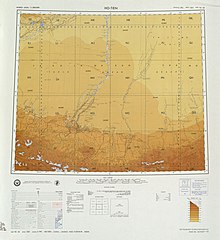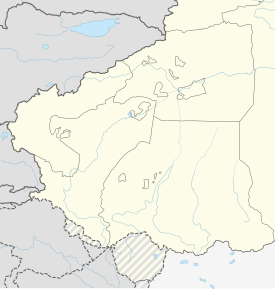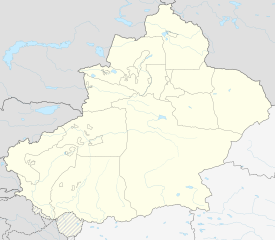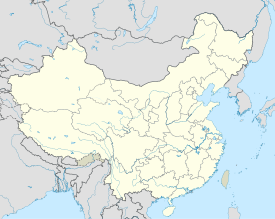Hotan County
Hotan County
Gosthana, Gaustana, Khotan, Hotien | |
|---|---|
 Farmland of Hotan County near the city | |
 Location of Hotan County (red) in Hotan Prefecture (yellow) and Xinjiang | |
| Coordinates: 37°05′26″N 79°49′44″E / 37.09056°N 79.82889°E | |
| Country | China |
| Autonomous region | Xinjiang |
| Prefecture | Hotan |
| County seat | Gujanbagh Subdistrict, Hotan[1][a] |
| Area | |
| • Total | 41,128 km2 (15,880 sq mi) |
| Population (2020)[5] | |
| • Total | 342,603 |
| • Density | 8.3/km2 (22/sq mi) |
| Ethnic groups | |
| • Major ethnic groups | Uyghur[4][6] |
| Time zone | UTC+8 (China Standard[c]) |
| Website | htx |
| Hotan County | |||||||||||||||
|---|---|---|---|---|---|---|---|---|---|---|---|---|---|---|---|
| Uyghur name | |||||||||||||||
| Uyghur | خوتەن ناھىيىسى | ||||||||||||||
| |||||||||||||||
| Chinese name | |||||||||||||||
| Simplified Chinese | 和田县 | ||||||||||||||
| Traditional Chinese | 和田縣 | ||||||||||||||
| |||||||||||||||
| Alternative Chinese name | |||||||||||||||
| Simplified Chinese | 和阗县 | ||||||||||||||
| Traditional Chinese | 和闐縣 | ||||||||||||||
| |||||||||||||||
| Second alternative Chinese name | |||||||||||||||
| Simplified Chinese | 于窴县 | ||||||||||||||
| Traditional Chinese | 于窴縣 | ||||||||||||||
| |||||||||||||||
Hotan County[7] (also known as Gosthana, Gaustana, Godana, Godaniya, Khotan, Hetian, Hotien)[8][9][10] is a county in the southwest of the Xinjiang Uyghur Autonomous Region and is under the administration of the Hotan Prefecture. Almost all the residents of the county are Uyghurs and live around oases situated between the desolate Taklamakan Desert and Kunlun Mountains. Hotan County is the southernmost county-level division of Xinjiang. The county borders Karakax/Moyu County to the northwest, Hotan City and Lop County to the northeast, Qira County to the east, Pishan County to the west, and (in Aksai Chin) Rutog County, Tibet to the southeast. Hotan County administers most of Aksai Chin,[3] an area disputed between China and India. The Line of Actual Control divides the India-controlled part of Ladakh union territory from the Aksai Chin area administered as part of southwest Hotan County.
Name[edit]
The area of Hotan is originally known as and has been historically referred to as Godana (Godaniya), a Sanskrit name meaning "Land of the cows". In Chinese, the same name is written as Yu-t'ien, pronounced as Gu-dana. It is referred to as Gosthana by local Tibetans, which also means the same in Sanskrit.[10]
History[edit]


On January 18, 1913, Hotan became a county.[3][11]
In 1919, Karakax/Moyu County was split off from Hotan County.[3]
In 1933, Muhammad Amin Bughra and his associates declared the Khotan Emirate.[11]
On December 22, 1949, the People's Liberation Army entered Hotan.[11]
In 1959, the Chinese character name for the county was set as '和田'.[3]
In 1962, some of the events of the Sino-Indian War occurred in the disputed Aksai Chin region.[12]
On April 12, 1969, during the Cultural Revolution, the Hotan County People's Government became the Hotan County Revolutionary Committee. In December 1979, the Hotan County Revolutionary Committee was disestablished and the Hotan County People's Government re-established.[11]
In 1983/4, the urban area of Hotan was administratively split from the larger Hotan County, and from then on governed as a county-level city.[3][13]
On September 9, 1995, Vice Premier Zhu Rongji visited Buzhake Township.[14]
On July 11, 2006, the township of Tusalla (Tushala), then part of Hotan County, was transferred to Hotan City.[2][13]
In 2012, Hanerik (Han'airike) was changed from a township into a town and Uzunsho (Wuzongxiao) township was established.[2]
On July 28, 2013, an incident involving Muslim protesters and local police in Hanerik (Han'airike/Hanairke) occurred.[15][16] Chinese state media said no one died during the confrontation. There were reports of protester deaths, as many as over 100.[17]
Geography[edit]
The northernmost point of the county is in the Taklamakan Desert at the confluence of the White Jade River and Karakash River, which together create the Hotan River.
Major lakes administered as part of Hotan County include the soda lakes Aksai Chin Lake and Surigh Yilganing Kol (Surigh-yilganing Köl; 萨利吉勒干南库勒湖),[18] both part of the disputed Aksai Chin. A Chinese military outpost called Tianshuihai[19] which is named for another lake, Tianshuihai (甜水海[18]), is also in the Hotan County administered part of the disputed Aksai Chin region. The Hotan County-administered part of Aksai Chin includes Tianwendian,[18] site of a Chinese military post.
Climate[edit]
Hotan County has a cool arid climate (Köppen climate classification BWk). The average annual temperature in Hotan is 13.0 °C (55.4 °F). The average annual rainfall is 44.1 mm (1.74 in) with July as the wettest month. The temperatures are highest on average in June, at around 25.8 °C (78.4 °F), and lowest in January, at around −3.9 °C (25.0 °F).
| Climate data for Hotan (1981−2010 normals, extremes 1981−2010) | |||||||||||||
|---|---|---|---|---|---|---|---|---|---|---|---|---|---|
| Month | Jan | Feb | Mar | Apr | May | Jun | Jul | Aug | Sep | Oct | Nov | Dec | Year |
| Record high °C (°F) | 20.5 (68.9) |
22.0 (71.6) |
30.6 (87.1) |
34.6 (94.3) |
37.6 (99.7) |
39.8 (103.6) |
41.1 (106.0) |
40.2 (104.4) |
35.9 (96.6) |
30.0 (86.0) |
24.7 (76.5) |
18.3 (64.9) |
41.1 (106.0) |
| Mean daily maximum °C (°F) | 1.3 (34.3) |
6.9 (44.4) |
15.8 (60.4) |
23.5 (74.3) |
27.8 (82.0) |
31.1 (88.0) |
32.6 (90.7) |
31.7 (89.1) |
27.4 (81.3) |
20.6 (69.1) |
11.6 (52.9) |
3.1 (37.6) |
19.5 (67.0) |
| Daily mean °C (°F) | −3.9 (25.0) |
1.3 (34.3) |
9.6 (49.3) |
16.8 (62.2) |
21.1 (70.0) |
24.3 (75.7) |
25.8 (78.4) |
24.9 (76.8) |
20.4 (68.7) |
13.2 (55.8) |
5.1 (41.2) |
−2.2 (28.0) |
13.0 (55.5) |
| Mean daily minimum °C (°F) | −8.2 (17.2) |
−3.4 (25.9) |
4.0 (39.2) |
10.7 (51.3) |
15.2 (59.4) |
18.5 (65.3) |
20.0 (68.0) |
19.3 (66.7) |
14.5 (58.1) |
7.0 (44.6) |
0.0 (32.0) |
−6.3 (20.7) |
7.6 (45.7) |
| Record low °C (°F) | −21.0 (−5.8) |
−19.3 (−2.7) |
−7.0 (19.4) |
−0.2 (31.6) |
4.3 (39.7) |
9.5 (49.1) |
12.2 (54.0) |
10.2 (50.4) |
4.3 (39.7) |
−2.1 (28.2) |
−12.3 (9.9) |
−19.3 (−2.7) |
−21.0 (−5.8) |
| Average precipitation mm (inches) | 1.9 (0.07) |
1.9 (0.07) |
2.5 (0.10) |
2.9 (0.11) |
7.2 (0.28) |
8.9 (0.35) |
7.2 (0.28) |
4.6 (0.18) |
3.6 (0.14) |
1.5 (0.06) |
0.5 (0.02) |
1.4 (0.06) |
44.1 (1.72) |
| Average relative humidity (%) | 54 | 44 | 32 | 29 | 34 | 38 | 43 | 44 | 44 | 41 | 43 | 54 | 42 |
| Source: China Meteorological Data Service Center[20] | |||||||||||||
Administrative divisions[edit]
Hotan County includes two towns, ten townships, and one other area:[2][21][4]
| Name | Simplified Chinese | Hanyu Pinyin | Uyghur (UEY) | Uyghur Latin (ULY) | Administrative division code | Notes | |
|---|---|---|---|---|---|---|---|
| Towns | |||||||
| Baghchi Town[22] (Bageqi Town[23]) |
巴格其镇 | Bāgéqí Zhèn | باغچى بازىرى | baghchi baziri | 653221100 | ||
| Hanerik Town | 罕艾日克镇 | Hǎn'àirìkè Zhèn | خانئېرىق بازىرى | xan'ëriq baziri | 653221102 | formerly Hanerik Township (罕艾日克乡) | |
| Townships | |||||||
| Yengiawat Township[24] | 英阿瓦提乡 | Yīng'āwǎtí Xiāng | يېڭىئاۋات يېزىسى[25] | yëngi'awat yëzisi | 653221202 | ||
| Yengierik Township | 英艾日克乡 | Yīng'àirìkè Xiāng | يېڭىئېرىق يېزىسى | yëngi'ëriq yëzisi | 653221203 | ||
| Bozak Township[26] (Buzhake,[14] Buzak[27]) |
布扎克乡 | Bùzhákè Xiāng | بۇزاق يېزىسى | buzaq yëzisi | 653221204 | ||
| Layka Township | 拉依喀乡 | Lāyīkā Xiāng | لايقا يېزىسى | layqa yëzisi | 653221205 | ||
| Langru Township | 朗如乡 | Lǎngrú Xiāng | لاڭرۇ يېزىسى | langru yëzisi | 653221206 | ||
| Tewekkul Township | 塔瓦库勒乡 | Tǎwǎkùlè Xiāng | تەۋەككۈل يېزىسى | tewekkül yëzisi | 653221207 | ||
| Islamawat Township | 伊斯拉木阿瓦提乡 | Yīsīlāmù'āwǎtí Xiāng | ئىسلامئاۋات يېزىسى | Islam'awat yëzisi | 653221208 | ||
| Seghizkol Township | 色格孜库勒乡 | Sègézīkùlè Xiāng | سېغىزكۆل يېزىسى | sëghizköl yëzisi | 653221209 | ||
| Qashteshi Township (Kashitashi[28]) | 喀什塔什乡 | Kāshítǎshí Xiāng | قاشتېشى يېزىسى | qashtëshi yëzisi | 653221210 | ||
| Uzunsho Township | 吾宗肖乡 | Wúzōngxiāo Xiāng | ئۇزۇنشو يېزىسى | Uzunsho yëzisi | 653221211 | ||
Other:
- Hotan County Economic New Area (和田县经济新区)
Economy[edit]
The county is known for Hotan Silk, Hotan Jade and Hotan Carpets. The county's agricultural products include wheat, rice, corn, melons, cotton, and silkworm cocoons.[3]
Demographics[edit]
| Year | Pop. | ±% p.a. |
|---|---|---|
| 2000 | 261,498 | — |
| 2010 | 269,941 | +0.32% |
| [2] | ||
In 1997, the population of Hotan County was 99% Uyghur.[6]
As of 2015, 325,117 of the 327,533 residents of the county were Uyghur, 2,023 were Han Chinese and 393 were from other ethnic groups.[29]
In 2019, the population of Hotan County was 99% Uyghur.[4]
As of 1999, 99.41% of the population of Hotan (Hetian) County was Uyghur and 0.46% of the population was Han Chinese.[30]
Transportation[edit]
- China National Highway 315
- China National Highway 219, which passes through the disputed Aksai Chin region
Notes[edit]
- ^ The government seat of Hotan County is located at Gujanbagh Subdistrict, Hotan City.[1]
- ^ includes the Sino-Indian disputed areas in Aksai Chin.
- ^ Locals in Xinjiang frequently observe UTC+6 (Xinjiang Time), 2 hours behind Beijing.
- ^ From map: "DELINEATION OF INTERNATIONAL BOUNDARIES MUST NOT BE CONSIDERED AUTHORITATIVE".
- ^ From map: "The representation of international boundaries is not necessarily authoritative."
References[edit]
- ^ a b 行政区划. Government of Hotan County.
和田县有县无城,县属机关单位分布在和田市区。
- ^ a b c d e 和田县历史沿革 [Hotan County Historical Development] (in Simplified Chinese). XZQH.org. 2 December 2014. Retrieved 23 December 2019.
2000年第五次人口普查,和田县常住总人口261498人,{...}2003年,和田县总面积41403.17平方千米,{...}2006年,将和田县吐沙拉乡划归和田市管辖。{...}2010年第六次人口普查,和田县常住总人口269941人,其中:巴格其镇57153人,罕艾日克乡43751人,英阿瓦提乡23624人,英艾日克乡10253人,布扎克乡27137人,拉依喀乡29032人,朗如乡16505人,塔瓦库勒乡26983人,伊斯拉木阿瓦提乡19828人,色格孜库勒乡9576人,喀什塔什乡6099人。 2012年,撤销罕艾日克乡,设立罕艾日克镇(新政函[2012]27号);设立吾宗肖乡,乡政府驻塔西力克村(新政函[2012]82号)。调整后,全县辖2个镇、10个乡:巴格其镇、罕艾日克镇、英阿瓦提乡、英艾日克乡、布扎克乡、拉依喀乡、朗如乡、塔瓦库勒乡、伊斯拉木阿瓦提乡、色格孜库勒乡、喀什塔什乡、吾宗肖乡。
- ^ a b c d e f g 夏征农; 陈至立, eds. (September 2009). 辞海:第六版彩图本 [Cihai (Sixth Edition in Color)] (in Chinese). 上海. Shanghai: 上海辞书出版社. Shanghai Lexicographical Publishing House. pp. 0008, 0866, 1610. ISBN 9787532628599.
阿克赛钦 地名区。{...}在新疆维吾尔自治区和田县南部、喀喇昆仑山和昆仑山间。{...}1983年由和田县析置。{...}面积4.14万平方千米。{...}清设和阗直隶州,1913年改和阗县,1959年改和田县。{...}产小麦、稻、玉米、瓜果、棉花和蚕茧。"和田玉"、"和田毯"、"和田绸"。{...}墨玉{...}1919年由和阗县(今和田县)析置。
- ^ a b c d 和田县史志办 (3 April 2019). 和田县简介 [Hotan County Overview]. 和田县政府门户网站 (in Simplified Chinese). Archived from the original on 18 January 2020. Retrieved 23 December 2019.
和田县位于新疆西南部,昆仑山北麓,塔克拉玛干沙漠南缘,处于玉龙喀什河和喀拉喀什河之间;国土总面积4.03万平方公里,其中,山区占95%,沙漠占3.7%,绿洲仅占1.3%;全县辖10乡2镇206个行政村,总人口36万人,其中维吾尔族占99%。
- ^ Xinjiang: Prefectures, Cities, Districts and Counties
- ^ a b 1997年和田县行政区划 [1997 Hotan County Administrative Divisions]. XZQH.org. 6 January 2011. Archived from the original on 30 October 2019. Retrieved 3 April 2020.
面积约40808.6平方千米,人口23.9万,有维吾尔、汉、回等民族。其中维吾尔族占99%,辖1镇11乡。
- ^ The official spelling is "Hotan" according to Zhōngguó dìmínglù. 中国地名录. Beijing: SinoMaps Press. 1997. p. 304. ISBN 7-5031-1718-4.
- ^ Higgins, Benjamin (November 1962). "The Philippines. Public Policy and National Economic Development. By Frank Golay. Ithaca: Cornell University Press, 1961. Xviii, 455. Map, Tables, Index, Bibliographic Essay". The Journal of Asian Studies. 22 (1): 114–116. doi:10.2307/2049929. JSTOR 2049929.
- ^ "How Sanskrit Language is Associated with the Tibet and Xinjiang?". 5 February 2020.
- ^ a b Wang, Bangwei; Sen, Tansen (2011). India and China: Interactions through Buddhism and Diplomacy: A Collection of Essays by Professor Prabodh Chandra Bagchi. Anthem Press. p. 186. ISBN 9780857288219.
- ^ a b c d 历史沿革. 和田县政府门户网站 (in Simplified Chinese). 22 March 2019. Retrieved 23 December 2019.
民国二年(1913)1月18日,撤销和阗直隶州建制,改称和阗县。民国九年(1920)设和阗道,民国十八年(1929)改为和阗行政区,设行政长公署,和阗县属和阗行政长公署管辖。1933年穆罕默德·伊敏等煽动组织民族分裂势力暴乱,成立"和阗伊斯兰共和国",1934年为马虎山部所破。1937年盛世才省军进驻和阗。民国三十二年(1943)设行政督察专员公署,和田县属专员公署管辖。1949年12月22日中国人民解放军十五轩进驻和阗,1950年6月,成立和阗县人民政府。1969年4月12日和田县人民政府改为和田县革命委员会。1979年12月,撤销和田县革命委员会,建立和田县人民政府。
- ^ Calvin, James Barnard (April 1984). "The China-India Border War". Marine Corps Command and Staff College. Archived from the original on 11 November 2011. Retrieved 15 October 2011.
On October 24th, four days after the outbreak of heavy fighting in NEFA and Aksai Chin
- ^ a b 和田市历史沿革 [Hotan City Historical Development] (in Simplified Chinese). XZQH.org. 2 December 2014. Retrieved 20 December 2019.
1984年和田县析置和田市。{...}2006年7月11日,洛浦县吉亚乡、玉龙喀什镇与和田县吐沙拉乡正式划归和田市管辖。
- ^ a b Zhu Rongji (2013). Zhu Rongji on the Record: The Road to Reform: 1991–1997. Translated by June Y. Mei. Washington, D.C.: Brookings Institution Press. p. xvi. ISBN 9780815725190 – via Google Books.
Talking with Uyghur cotton growers in Buzhake Township, Hotan County, Xinjiang Uyghur Autonomous Region, on September 9, 1995.
- ^ Chris Buckley (28 June 2013). "Violence Erupts Anew in Volatile Chinese Region". New York Times. Archived from the original on 23 December 2019. Retrieved 23 December 2019.
- ^ Shohret Hoshur, Joshua Lipes (28 July 2013). "Two Uyghurs Believed Killed in Hotan Violence". Radio Free Asia. Translated by Dolkun Kamberi and Luisetta Mudie. Archived from the original on 23 December 2019. Retrieved 23 December 2019.
- ^ Andrew Jacobs (26 August 2013). "Over News of Clash, a Shroud of Silence in Xinjiang". New York Times. Archived from the original on 30 December 2019. Retrieved 23 December 2019.
Although the state media said that no one died during the confrontation between villagers and armed police officers, numerous sources say that dozens were shot dead on the highway that connects Hanerik to Hotan, which the Chinese call Hetian. Exile groups say the death toll may exceed 100.
- ^ a b c 地貌气候. 和田县政府门户网站 (in Simplified Chinese). 29 April 2019. Retrieved 23 December 2019.
和田县境内有主要湖泊5处:阿克赛钦湖,距县城200千米,面积158平方米,湖面高程 4 963米;萨利吉勒干南库勒湖,距县城260千米,湖面高程5 200米;列腾格湖,距县城260千米,湖水面积9.3平方千米;甜水海;长千湖,湖水面积8平方千米。{...}海拔5 000米以上的天文点、空喀山口一带,
- ^ Robert Kerry; John Vincent Bellezza, eds. (February 2008). Tibet. Lonely Planet (7 ed.). p. 2, 339. ISBN 9781741045697 – via Internet Archive.
Tianshuihai{...}From here the road turns south, and climbs to the Khitai Pass (kilometre marker 535; 5150m), past the military base of Tianshuihai.
- ^ 中国地面气候标准值月值(1981-2010) (in Chinese (China)). China Meteorological Data Service Center. Retrieved January 16, 2023.
- ^ 2018年统计用区划代码和城乡划分代码:和田县 [2018 Statistical Area Numbers and Rural-Urban Area Numbers: Hotan County] (in Simplified Chinese). National Bureau of Statistics of the People's Republic of China. 2018. Archived from the original on 22 December 2019. Retrieved 23 December 2019.
统计用区划代码 名称 653221100000 巴格其镇 653221102000 罕艾日克镇 653221202000 英阿瓦提乡 653221203000 英艾日克乡 653221204000 布扎克乡 653221205000 拉依喀乡 653221206000 朗如乡 653221207000 塔瓦库勒乡 653221208000 伊斯拉木阿瓦提乡 653221209000 色格孜库勒乡 653221210000 喀什塔什乡 653221211000 吾宗肖乡 653221401000 和田县经济新区
- ^ huaxia, ed. (17 September 2020). "Full Text: Employment and Labor Rights in Xinjiang". Xinhua News Agency. Retrieved 20 September 2020.
In 2019, a survey in three villages of Baghchi Town, Hotan County, Hotan Prefecture counted a total population of 5,307, with 1,699 people capable of work, of whom, 1,493, or 88 percent, were keen to work outside their home villages. Of the remainder, 180 preferred to work locally in township enterprises, village factories, or poverty-relief cooperatives offering an average monthly salary of RMB3,000; the other 26 wished to start businesses locally, engaging in transport and logistics, property management and household services, construction, hairdressing, catering or retail stores.
- ^ Chen Xuejian, ed. (2008). Travel Around China. Hong Kong: HarperCollins. p. 209. ISBN 978-0-06-1473548 – via Internet Archive.
This ancient site is situated in the village of Yuetegan of the town of Bageqi, Hetian County, 8 miles from Hetian, covering about 4 square miles.
- ^ Yengiawat (Approved - N) at GEOnet Names Server, United States National Geospatial-Intelligence Agency
- ^ خوتەنلىك 171 دېھقان ئىشلەمچى ھۆددە ئايروپىلانغا ئولتۇرۇپ، خۇنەندىكى ئىش ئورنىغا ئىشلەشكە ماڭدى. ﺷﯩﻨﺠﺎﯓ ﻛﯘﺋﯧﻨﻠﯘﻥ ﺗﻮﺭﻯ (in Uyghur). 23 February 2020. Retrieved 3 April 2020.
خوتەن ناھىيەسى يېڭىئاۋات يېزىسى
- ^ Xie Yuzhong 解玉忠 (2003). 地名中的新疆 (in Simplified Chinese). Ürümqi: 新疆人民出版社. p. 242. ISBN 7-228-08004-1.
布扎克 Bozak
- ^ Zhong Xingqi 钟兴麒, ed. (July 2008). 西域地名考录 (in Simplified Chinese). Beijing: 国家图书馆出版社. p. 163. ISBN 978-7-5013-3628-9.
布扎克 bù zhā kè Buzak
- ^ Chu Meng (14 September 2007). "Russian plane arrives for missing tourists". Beijing Today. p. 2. Retrieved 23 December 2019 – via Internet Archive.
According to the original plan, the expedition team was to meet Zhang at Kashitashi Township in Hotan County, 30 kilometers from Hotan City.
- ^ 3-7 各地、州、市、县(市)分民族人口数 (in Simplified Chinese). شىنجاڭ ئۇيغۇر ئاپتونوم رايونى 新疆维吾尔自治区统计局 Statistic Bureau of Xinjiang Uygur Autonomous Region. 15 March 2017. Archived from the original on 11 October 2017. Retrieved 3 September 2017.
- ^ Morris Rossabi, ed. (2004). Governing China's Multiethnic Frontiers (PDF). University of Washington Press. p. 180. ISBN 0-295-98390-6. Archived (PDF) from the original on 2020-01-07. Retrieved 2020-05-04.



